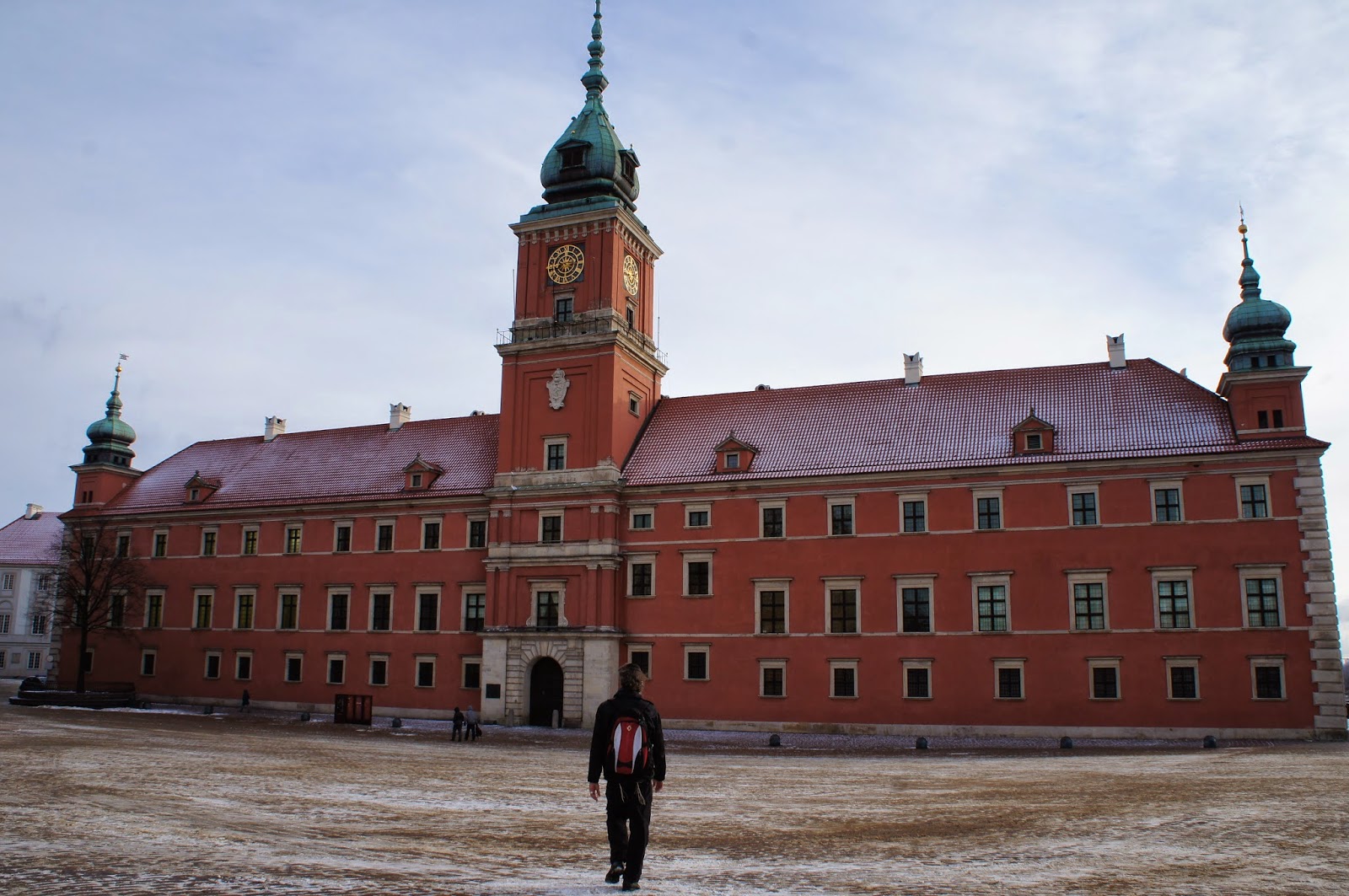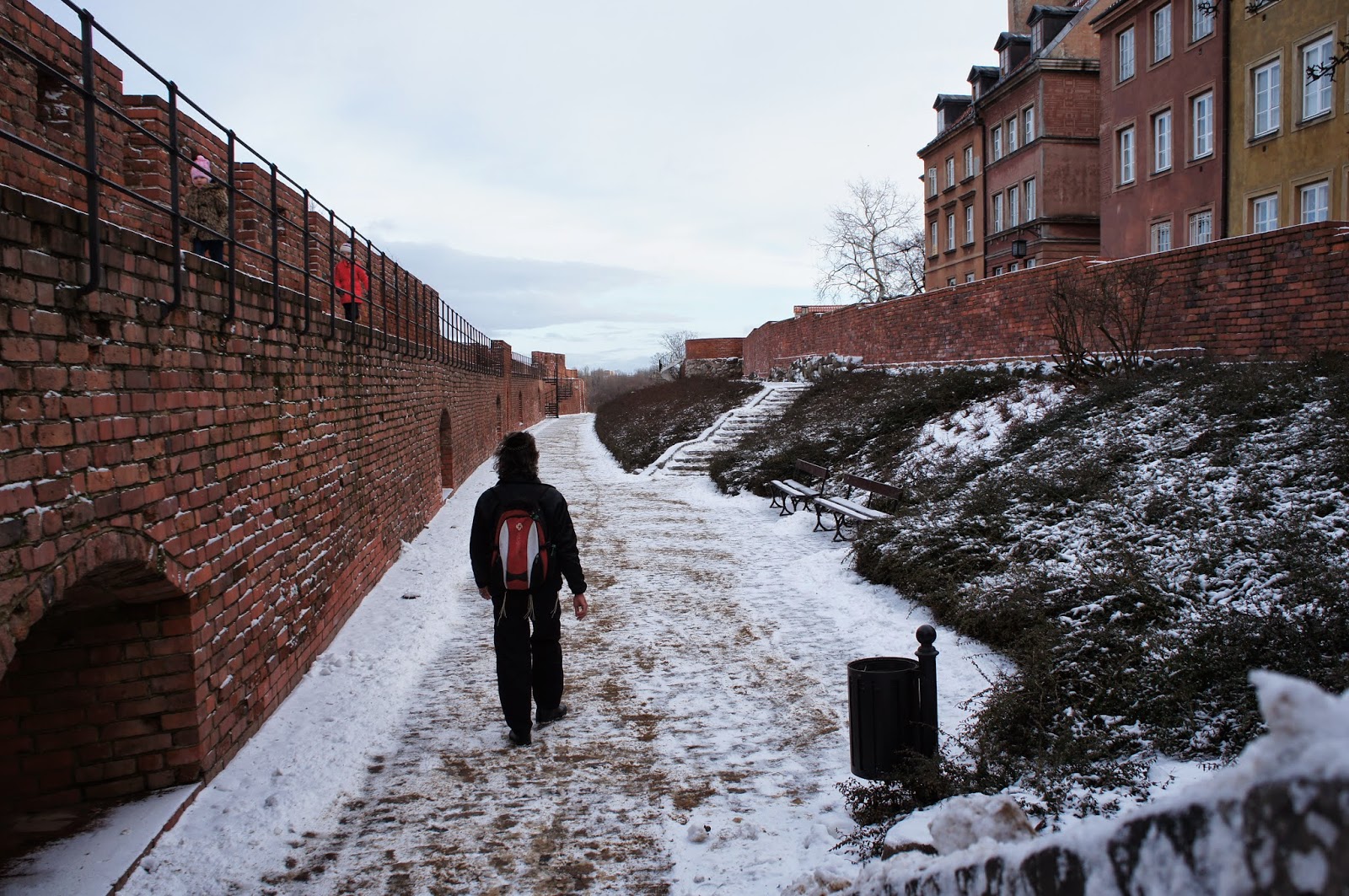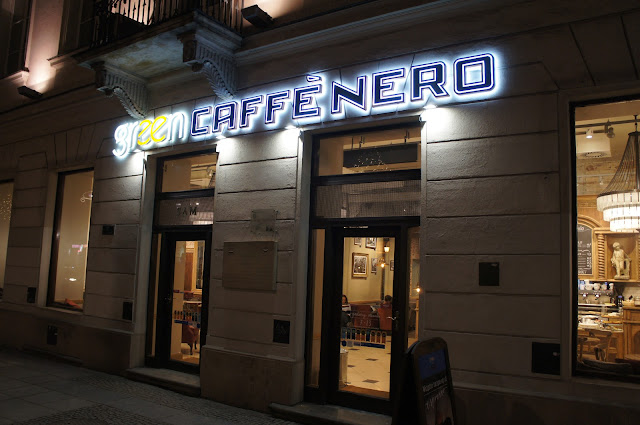JACOB JR, MY JEWISH WORLD. OLD TOWN (STARE MIASTO), WARSZAWA/POLAND
 |
| Royal Castle (Zamek Królewski) |
YOM RISHOM, 30 NISSAN, 5775, SUNDAY, APRIL 19, 2015
Shalom! World.
A labyrinth of winding cobblestone streets, ornate tenement facades and picturesque plazas with plenty of Old World charm, it's easy to understand why the Old Town in Warszawa's top tourist area. Entirely rebuilt after the Warszawa Uprising of 1944, the Old Town is also symbolic of Warszawa's rise from the ruins of WWII and Warszawaians' pride in their city.

 When US General Dwight Eisenhower visited Warszawa after the war he was moved to comment, "I have seen many towns destroyed, but nowwhere have i been faced with such destruction." Buried beneath twenty million cubic metres of rubble the city resembled a shaterred shell: over half the population had been killed and 85% of the city razed to the ground. The old Town had been hit with particular nazi efficiency, and by the time the Red Army rolled across the river it was little more than a smoudering wasteland. To their credit the Capital Reconstruction Bureau chose to rebuid the historic centre, a paintstaking process that would last until 1962. Using pre-war sketches, painting, and photographes the Old Town was carefully rebuilt, though only at the consideralble expense of Poland's 'recovered territories'. Although now only half a century old, Warszawa's historic quarter is an architectural miracle, and a stunning tribute to the city's will to survive.
When US General Dwight Eisenhower visited Warszawa after the war he was moved to comment, "I have seen many towns destroyed, but nowwhere have i been faced with such destruction." Buried beneath twenty million cubic metres of rubble the city resembled a shaterred shell: over half the population had been killed and 85% of the city razed to the ground. The old Town had been hit with particular nazi efficiency, and by the time the Red Army rolled across the river it was little more than a smoudering wasteland. To their credit the Capital Reconstruction Bureau chose to rebuid the historic centre, a paintstaking process that would last until 1962. Using pre-war sketches, painting, and photographes the Old Town was carefully rebuilt, though only at the consideralble expense of Poland's 'recovered territories'. Although now only half a century old, Warszawa's historic quarter is an architectural miracle, and a stunning tribute to the city's will to survive.
 The decision to build the Royal Castle (Zamek Królewski) was made when Zygmunt III Vasa moved the capital from Krakow to Warszawa in 1596. It was built in the early Baroque style by the Italian aschitects Giovanni Trevano, Giacomo Rodondo and Matteo Castelli between 1598 and 1619, incorporating the earlier castle of the Mazovian princes. Successive rules remodelled the castle many times. The late Baroque façade overlooking the River Vistula dates from the time of August III, and the spendid interiors from that of Stanislaw August. Completely destrouyed by the germans during Wiold War II, the castle was reconstructed from 1971 to 1988.
The decision to build the Royal Castle (Zamek Królewski) was made when Zygmunt III Vasa moved the capital from Krakow to Warszawa in 1596. It was built in the early Baroque style by the Italian aschitects Giovanni Trevano, Giacomo Rodondo and Matteo Castelli between 1598 and 1619, incorporating the earlier castle of the Mazovian princes. Successive rules remodelled the castle many times. The late Baroque façade overlooking the River Vistula dates from the time of August III, and the spendid interiors from that of Stanislaw August. Completely destrouyed by the germans during Wiold War II, the castle was reconstructed from 1971 to 1988.
 Zygmunt's Column, in the centre of Plac Zamkowy, is the oldest secular statue in Warszawa. It was ercted in 1644 by Zygmunt III's son Wladyslaw IV. The monument, which stands 22m high, consists of a Corinthian granite column supported on a tall plinth and topped with a bronze statue of the ruler, who is depicted with a cross in his left hand a sword in his right. The figure is the work of Clemente Molli, and the whole monument was designed by Augustyn Locci the Elder and Constantino Tencalla, two italian architects working for the king. This monument, unusual in European terms, glorifies the secular ruler in a manner which had until then been reserved for saints and other religious subjects. Despite repeated damage and repairs, the statue retains its original appearence. The column on which it stands, however, has already been replaced twice. An older, fractured shaft can been seen on the terrace near the south façade of the Palace Under the Tin Roof.
Zygmunt's Column, in the centre of Plac Zamkowy, is the oldest secular statue in Warszawa. It was ercted in 1644 by Zygmunt III's son Wladyslaw IV. The monument, which stands 22m high, consists of a Corinthian granite column supported on a tall plinth and topped with a bronze statue of the ruler, who is depicted with a cross in his left hand a sword in his right. The figure is the work of Clemente Molli, and the whole monument was designed by Augustyn Locci the Elder and Constantino Tencalla, two italian architects working for the king. This monument, unusual in European terms, glorifies the secular ruler in a manner which had until then been reserved for saints and other religious subjects. Despite repeated damage and repairs, the statue retains its original appearence. The column on which it stands, however, has already been replaced twice. An older, fractured shaft can been seen on the terrace near the south façade of the Palace Under the Tin Roof.

 Rynek Starego Miasta. Until the end of the 18th century, this rectangular market square was the most important place in Warszawa. The houses around the square were built by the most affluent members of the community. Most of them date from the 1600s, and it is these that give the square its period character. In the center was once a town hall, a weigh house and stalls, all demolished in 1817. In their place now stands a statue of the Mermaid (Syrenka).
Rynek Starego Miasta. Until the end of the 18th century, this rectangular market square was the most important place in Warszawa. The houses around the square were built by the most affluent members of the community. Most of them date from the 1600s, and it is these that give the square its period character. In the center was once a town hall, a weigh house and stalls, all demolished in 1817. In their place now stands a statue of the Mermaid (Syrenka).
Warszawa is one of the European capitals where a large portion of the old city wall began in the first half of the 14th century. A double circumvallation, reinforced with fortresses and towers, encircled the town. The earlist part of the fortifications is the Barbican, erected around 1548 by Gianbattista of Venice. It was built on the site of an earlier outer gate and was intended to defend the Nowomiejska Gate (Brama Nowomeijska).


The northern part of this defensive building, in the form of a dungeon reinforced by four semicircular towers, survived as the external wall of a town house. After World War II, parts of the wall were rebuilt and the Barbican, which had ceased to exist for a long period, was restored to its full scale.
 Today the Barbican serves as a bridge between the Old and New Town, and is also the hangout of chice for teenage drinkers and 'artists' selling their wares. During the summer months you can visit the interior, though it's best avoided if you have an aversion to confined spaces. The moat around the area filled in back in the 18th century and the walls were incorporated into the dense tangle of new townhouses. Fragments of these forgotten defences were unearthed in 1937 and a decade later, with Warszawa in ruins, architects took the decision to restore the ancient walls.
Today the Barbican serves as a bridge between the Old and New Town, and is also the hangout of chice for teenage drinkers and 'artists' selling their wares. During the summer months you can visit the interior, though it's best avoided if you have an aversion to confined spaces. The moat around the area filled in back in the 18th century and the walls were incorporated into the dense tangle of new townhouses. Fragments of these forgotten defences were unearthed in 1937 and a decade later, with Warszawa in ruins, architects took the decision to restore the ancient walls.
Shalom! Aleichem.

 When US General Dwight Eisenhower visited Warszawa after the war he was moved to comment, "I have seen many towns destroyed, but nowwhere have i been faced with such destruction." Buried beneath twenty million cubic metres of rubble the city resembled a shaterred shell: over half the population had been killed and 85% of the city razed to the ground. The old Town had been hit with particular nazi efficiency, and by the time the Red Army rolled across the river it was little more than a smoudering wasteland. To their credit the Capital Reconstruction Bureau chose to rebuid the historic centre, a paintstaking process that would last until 1962. Using pre-war sketches, painting, and photographes the Old Town was carefully rebuilt, though only at the consideralble expense of Poland's 'recovered territories'. Although now only half a century old, Warszawa's historic quarter is an architectural miracle, and a stunning tribute to the city's will to survive.
When US General Dwight Eisenhower visited Warszawa after the war he was moved to comment, "I have seen many towns destroyed, but nowwhere have i been faced with such destruction." Buried beneath twenty million cubic metres of rubble the city resembled a shaterred shell: over half the population had been killed and 85% of the city razed to the ground. The old Town had been hit with particular nazi efficiency, and by the time the Red Army rolled across the river it was little more than a smoudering wasteland. To their credit the Capital Reconstruction Bureau chose to rebuid the historic centre, a paintstaking process that would last until 1962. Using pre-war sketches, painting, and photographes the Old Town was carefully rebuilt, though only at the consideralble expense of Poland's 'recovered territories'. Although now only half a century old, Warszawa's historic quarter is an architectural miracle, and a stunning tribute to the city's will to survive. |
| Royal Castle (Zamek Królewski) |
 The decision to build the Royal Castle (Zamek Królewski) was made when Zygmunt III Vasa moved the capital from Krakow to Warszawa in 1596. It was built in the early Baroque style by the Italian aschitects Giovanni Trevano, Giacomo Rodondo and Matteo Castelli between 1598 and 1619, incorporating the earlier castle of the Mazovian princes. Successive rules remodelled the castle many times. The late Baroque façade overlooking the River Vistula dates from the time of August III, and the spendid interiors from that of Stanislaw August. Completely destrouyed by the germans during Wiold War II, the castle was reconstructed from 1971 to 1988.
The decision to build the Royal Castle (Zamek Królewski) was made when Zygmunt III Vasa moved the capital from Krakow to Warszawa in 1596. It was built in the early Baroque style by the Italian aschitects Giovanni Trevano, Giacomo Rodondo and Matteo Castelli between 1598 and 1619, incorporating the earlier castle of the Mazovian princes. Successive rules remodelled the castle many times. The late Baroque façade overlooking the River Vistula dates from the time of August III, and the spendid interiors from that of Stanislaw August. Completely destrouyed by the germans during Wiold War II, the castle was reconstructed from 1971 to 1988. Zygmunt's Column, in the centre of Plac Zamkowy, is the oldest secular statue in Warszawa. It was ercted in 1644 by Zygmunt III's son Wladyslaw IV. The monument, which stands 22m high, consists of a Corinthian granite column supported on a tall plinth and topped with a bronze statue of the ruler, who is depicted with a cross in his left hand a sword in his right. The figure is the work of Clemente Molli, and the whole monument was designed by Augustyn Locci the Elder and Constantino Tencalla, two italian architects working for the king. This monument, unusual in European terms, glorifies the secular ruler in a manner which had until then been reserved for saints and other religious subjects. Despite repeated damage and repairs, the statue retains its original appearence. The column on which it stands, however, has already been replaced twice. An older, fractured shaft can been seen on the terrace near the south façade of the Palace Under the Tin Roof.
Zygmunt's Column, in the centre of Plac Zamkowy, is the oldest secular statue in Warszawa. It was ercted in 1644 by Zygmunt III's son Wladyslaw IV. The monument, which stands 22m high, consists of a Corinthian granite column supported on a tall plinth and topped with a bronze statue of the ruler, who is depicted with a cross in his left hand a sword in his right. The figure is the work of Clemente Molli, and the whole monument was designed by Augustyn Locci the Elder and Constantino Tencalla, two italian architects working for the king. This monument, unusual in European terms, glorifies the secular ruler in a manner which had until then been reserved for saints and other religious subjects. Despite repeated damage and repairs, the statue retains its original appearence. The column on which it stands, however, has already been replaced twice. An older, fractured shaft can been seen on the terrace near the south façade of the Palace Under the Tin Roof.
 Rynek Starego Miasta. Until the end of the 18th century, this rectangular market square was the most important place in Warszawa. The houses around the square were built by the most affluent members of the community. Most of them date from the 1600s, and it is these that give the square its period character. In the center was once a town hall, a weigh house and stalls, all demolished in 1817. In their place now stands a statue of the Mermaid (Syrenka).
Rynek Starego Miasta. Until the end of the 18th century, this rectangular market square was the most important place in Warszawa. The houses around the square were built by the most affluent members of the community. Most of them date from the 1600s, and it is these that give the square its period character. In the center was once a town hall, a weigh house and stalls, all demolished in 1817. In their place now stands a statue of the Mermaid (Syrenka).

The northern part of this defensive building, in the form of a dungeon reinforced by four semicircular towers, survived as the external wall of a town house. After World War II, parts of the wall were rebuilt and the Barbican, which had ceased to exist for a long period, was restored to its full scale.
 Today the Barbican serves as a bridge between the Old and New Town, and is also the hangout of chice for teenage drinkers and 'artists' selling their wares. During the summer months you can visit the interior, though it's best avoided if you have an aversion to confined spaces. The moat around the area filled in back in the 18th century and the walls were incorporated into the dense tangle of new townhouses. Fragments of these forgotten defences were unearthed in 1937 and a decade later, with Warszawa in ruins, architects took the decision to restore the ancient walls.
Today the Barbican serves as a bridge between the Old and New Town, and is also the hangout of chice for teenage drinkers and 'artists' selling their wares. During the summer months you can visit the interior, though it's best avoided if you have an aversion to confined spaces. The moat around the area filled in back in the 18th century and the walls were incorporated into the dense tangle of new townhouses. Fragments of these forgotten defences were unearthed in 1937 and a decade later, with Warszawa in ruins, architects took the decision to restore the ancient walls.Shalom! Aleichem.
Suporte cultural: SOUL avec L'Integration d'Association avec Israel et dans le Monde/Fr .










Comments
Post a Comment